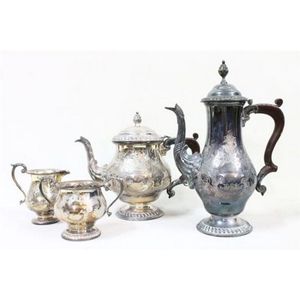Angell Sterling Silver Tea Service with Figurative Finials
You must be a subscriber, and be logged in to view price and dealer details.
Subscribe Now to view actual auction price for this item
When you subscribe, you have the option of setting the currency in which to display prices to $Au, $US, $NZ or Stg.
- Sterling Silver - Sterling silver is a mixture of 92.5% pure silver and 7.5% of another metal, usually copper. Fine silver is 99.9% pure silver, and is relatively soft and the addition of the very small amount of copper gives the metal enough strength and hardness to be worked into jewellery, decorative and household objects.
- Angell Family of Silversmiths - There were a number of members of the Angell family who were silversmiths, commencing with Joseph Angell I (also expressed as Joseph Angell, Senior), and his brothers John Angell and Abraham Angell.
On the retirement of Joseph Angell I in 1948, from what had become the leading London silverware workshop, the business was taken over by his son, Joseph Angell II (also expressed as Joseph Angell, Junior), (1815 - 1891).
Joseph Angell II exhibited at the at the 1851 Great Exhibition, the 1853 New York Exhibition, and the 1862 International Exhibition winning medals at each event.
His career is marked by the rich silver items crafted and decorated with chiseling, reliefs and enamels, including trays, tea and coffee sets, jugs, centrepieces and vases
The Victoria and Albert Museum in London holds a number of silver objects by Jospeh Angell II. - Engraving - The method of decorating or creating inscriptions on silver and other metal objects by marking the surface with a sharp instrument such as a diamond point or rotating cutting wheel.
- Finial - An architectural decoration, found on the upper parts of of an object. On furniture they are usually found on pediments, canopies and shelf supports. On smaller ceramic or silver items, such as spoons, they may decorate the top of the item itself, or the lid or cover where they provide a useful handle for removal.
Finials have a variety of shapes and forms. They may be urn-shaped, baluster shaped round or spiral, but usually taper into an upper point. Many real life shapes may also be used as finials, such as pineapples, berries, pinecones, buds, lotus and acorns. Sometimes animals such as a lion are depicted, or fish and dolphins.
This item has been included into following indexes:
- Angell family (England) - silversmiths 68
- Angell, George (London) - silver, maker or retailer 24
-
tea sets/services
- silver, four piece 317
- silver, Victorian 327
Visually similar items

English hallmarked sterling silver George III coffee pot from the Estate of the late Eric Dare, decorated with later heavy floral embossing London, 1772, maker Andrew Fogelberg height 28.5 cm weight including timber handle 805g

A Hardy Bros, silver plate on copper decorated Sheffiled plate tea & coffee service, comprising tea, coffee, sugar & creamer

A Victorian silver coffee pot, tall baluster form, the panelled sides with engraved scroll and floral decoration, raised on four scroll feet, the high domed lid with hexagonal urn finial, ivory heat rings. London 1853 by William Hunter. Weight 942gms.

A Victorian silver teapot, of compressed pear shape, heavily embossed with florals, the dome lid with floral finial and the scroll handle with acanthus capping. London 1856 by Daniel & Charles Houle. 835gms.
